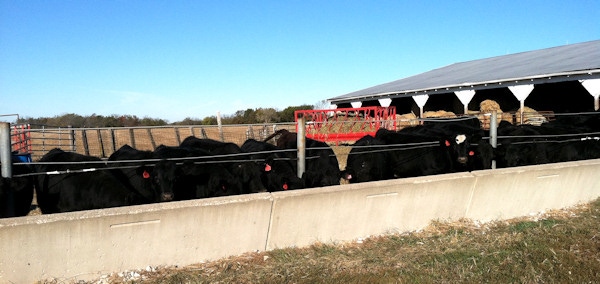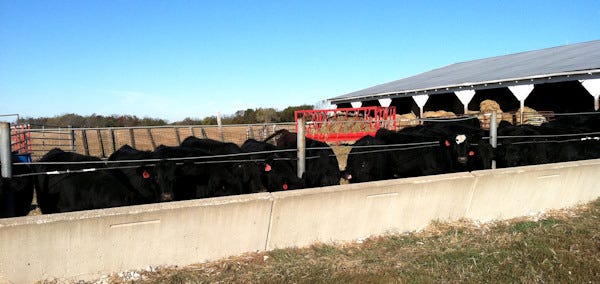
From the outside looking in, the U.S. beef industry can be a titch confusing. Actually, sometimes from the inside, it can be a titch confusing.

Let's eat.
To start with, you have two basic types of herds, particularly here in Illinois. Either you're a purebred seedstock cattle operation, or a commercial crossbred cattle operation. The first means you are raising animals for genetic superiority, so you're looking for calves that have a particular trait or set of traits that will make them better cows or bulls - good feet and sound legs that aren't too straight or too crooked, a thick hind quarter, smooth shoulders and an even topline, plenty of depth of body, just to start with. Typically, you're raising one breed, and you've been in that breed for a long time. You may well show your cattle, too. You're likely selling bulls and females to other cattlemen for use in their herds, and you're keeping back females with favorable traits into your own herd.
(This is the type of operation I grew up in. We knew not of steers; dad used to say you had to ruin a good bull to get a steer. Certainly, the feeding economics of $7 makes that equation a bit different these days.)
The second means you are raising crossbred cows and calves, and you're raising calves that will go directly into the food supply. Typically, you're raising crossbred cows (say, Angus-Simmental crossbreds) and breeding them to another bull (maybe a Maine-Anjou or a Simmental bull). You may also save back favorable females for your herd.
(This is the type of operation I married into.)
On our farm, we calve in late February and early March. The cows and calves run on pasture all spring and summer. We wean the calves in August. At that point, the calves weigh between 500 and 700 pounds, and we'll begin "backgrounding" them - meaning, we'll feed them until early January when they'll weigh between 700 and 900 pounds, then we'll sell them to a feeder. We background the calves; the feeder finishes the calves, then sells them to the packer. Then, small packages.
Backgrounding is a busy time for us, with lots of feeding and chores to be done. The calves eat a mixture of corn silage (bagged back in August), corn, soybean hull pellets and gluten pellets. They like it a lot. We do, too.
The sale takes place in early January, and we usually sell our calves at the Certified Angus Beef sale at our local livestock sale barn. The check we receive from this sale represents our entire income from the cattle portion of our business, for the entire year. Which is to say, it's a big deal, and it's part of why we started selling in the CAB sale; calves have to meet a set of requirements including two rounds of vaccinations, and we can net a little more profit for providing a higher-quality product.
Clearly, this is the tip of the iceberg in sharing more about the U.S. beef industry. But as a parting shot, I'll add this: our calves are finished on grain but that doesn't mean they haven't been on grass, too. Too often in the grass-fed vs grain-fed beef debate, I see the sides presented as though they are mutually exclusive, and that's not the case. Grain fed beef simply means the animal was finished on grain. It spent the first half of its life, in the vast majority of cases, out on pasture being…grass fed. Clearly, a difference, and certainly, consumers should have a choice. But I sure hate to hear "grain fed" presented as though these poor hapless animals are forced to swallow an all-corn diet for their entire lives. So not true. Also expensive, but that an economics lesson for another day.
Are you a consumer who wants to know more about beef, from gate to plate? Check the CAB Black Ink blog this month! They're blogging along with us and sharing 30 Days of Beef - Gate to Plate. Good stuff.
The archives: 30 Days on a Prairie Farm
Kickoff: 30 Days on a Prairie Farm
Day 14: Leave the Farm
Day 15: Dialogue
Day 16: Store Grain
Day 17: Love
Day 18: Kid Love
Day 19: Straight Rows
More "30 Days" farm blogs
Looking for more 30 Days goodness? My Generation has friends and we're all blogging a "30 Days" series in November. Check out what these farm bloggers are talking about this month.
Beyer Beware: 30 Days, 30 Things You Never Knew About Food
Black Ink: Beef's a Trip - 30 Days from Gate to Plate
Confessions of a Farm Wife: 30 Days of Life on our Farm
Le Jardin da ma Vie: 30 Reasons Why I Love Being a Farmer's Wife
Go Go Bookworm: 30 Days of Farm Kid Stories
Kelly McCormick Photography: 30 Days of Thankfulness
Pinke Post: 30 Days of a North Dakota November
Go Beyond the Barn: 30 Days of Farm Life Blessings
Rural Route 2: 30 Days of the Not-So-Glamorous Life of This Farm Wife
Touching Families: 30 Days of a Town Girl Touched by the Farming Life
This Land, This Life, This Farmer's Wife: 30 Days of Thankfulness on a Family Farm
Farmgirldays: 30 Days of Farm Kids Trapped in the City
My Cows and Pigs: 30 Days of "What's that?"
Dennis Olmstead: 30 Days in a Row
White House on the Prairie: 30 Days, 30 Posts
A Colorful Adventure: 30 Days of JP
About the Author(s)
You May Also Like






